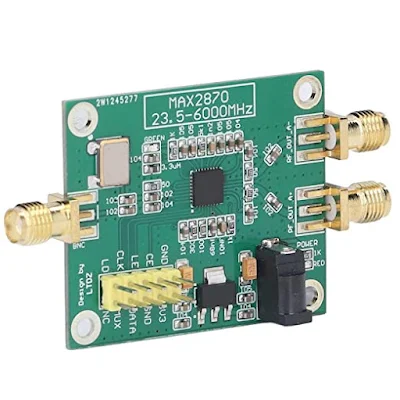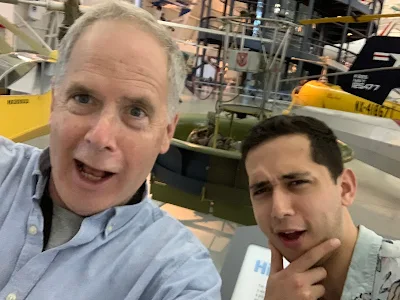Podcasting since 2005! Listen to Latest SolderSmoke
Sunday, March 20, 2022
Flick Lives -- More from a Great Web Site about "Jean Shepherd"
Friday, March 18, 2022
Help! Can You Write the Software to Control the MAX2870 Board?
Thursday, March 17, 2022
Colin M1BUU's Homebrew Manhattan SST
Wednesday, March 16, 2022
Pete N6QW Looks at Tapped Capacitance Impedance Matching
Tuesday, March 15, 2022
VK2BLQ's Two-Tube Regen with a SolderSmoke Dial
Monday, March 14, 2022
"Fashion" for Fans of LC Analog VFOs
Sunday, March 13, 2022
Video #3 17/12 Transceiver -- Receiver is Working on 12 and 17 meters (Listen! Video!)
Wednesday, March 9, 2022
Video #2 17/12 SSB Transceiver -- Receive RF Amplifier Needed?
Tuesday, March 8, 2022
Soldering to Aluminum with Mineral Oil
Hack-A-Day has a potentially useful workshop tip. Has anyone tried this?
https://hackaday.com/2022/03/06/how-to-solder-to-aluminum-easily/
Thursday, March 3, 2022
Tuesday, March 1, 2022
Dennis WC8C's FB Homebrew 6 Meter Rig -- Any Ideas or Suggestions?
This is my 6 Meter homebrew transceiver, currently work in
progress. It is a single conversion
super –heterodyne design. I constructed
each stage independently with SMA connectors.
This is so I can re-make sections as needed, and will allow me in the
future to swap sections to experiment with alternate designs. The VFO and BFO are controlled using a SI5351
with an Arduino micro controller. I
currently have separate SI5351 modules for VFO and BFO because I suspected
issues with cross-talk. These issues may
not actually be real, so once I am happy with the performance, I will test
again with just one module to see if it is OK.
The Power Amp is still on the to-do list, so output is well under 0 DBm
The Blue boards were designed by me and ordered
on-line. The other boards I etched
myself. Construction is mostly surface
mount because I find it easier than drilling all the holes. SMD components are mostly 805 and 1206 size.
Transistors are SOT23.
The Band Pass filter is a 5 coil design made with air-core
inductors.
3 bi-directional termination insensitive (TIA) amps are used
(blue boards). Total RX gain is about
44db. Total TX gain is about 16db. Each board has its own independent RX/TX
switching circuitry (mosfet based) and is fed with +12.5, GND, and RX/TX logic
signal from the Arduino (3V logic and up will work)
The Mixer and modulator are both Diode Ring mixers.
The 12 MHz SSB filter is a crystal ladder filter similar to
the one used in the uBitx.
The Mic and audio pre-amp (also a blue board) is made on a
modified TIA amp board. I had 10 of
these boards made, and the needed circuitry was largely the same, so I modified
the board with a rotary tool and jumpers.
The Audio amp is a PAM8403 module and drives a headset. I did make some modifications to the module so
it runs in-spec and to eliminate the power on audio pop.
The challenges I have been having are mostly related to
spurs, splatter, carrier suppression and TX audio quality. I have been gradually tweaking these things
to improve operation before I start on a power amp. My IF is 12 MHZ, and I was using the LSB side
of the crystal filter because it is sharper (VFO 62 – 66 MHz) but have recently
changed over to the USB side of the filter (VFO 38 – 42 MHz). This eliminated the spurs I was seeing near the
pass band. I still need to make some
adjustments to the crystal filter as it is too broad.
I still have some splatter and audio quality seems low, but
I am starting to doubt my test setup. I
see the splatter on the RTL SDR, but I don’t see it on the Tiny SA. The spatter happens at ~160 KHz
intervals. I am hoping to find someone
local with a better spectrum analyzer to help me verify if it is the rig or my
SDR dongle/test setup.
The modules to the side of the picture are my
rejects/experiments. The one covered in
copper shows how I eventually will shield all the modules. I 3D printed a cover for the board, when
wrapped it with copper tape, soldered to the bottom ground plane. The one shown is a diode ring modulator. For some unknown reason the carrier
suppression is rather poor. I had
previously made a junk-box modulator that had much better carrier
suppression. I don’t know why it is
better than the one I more carefully made for the radio, but until I figure it
out, I am using the junk box version.
The junk box modulator uses unmatched schottkey diodes, whereas the
“final” one uses a 4 diode SMD package because I wanted them matched – I
thought this would be better, but maybe not.
Monday, February 28, 2022
Free Download of AADE Filter Design Software
Very useful when homebrewing filters. I am using it now to build crystal filters.
http://www.ke5fx.com/aadeflt.htm
Thanks to KE5FX
LA6NCA Designs and Builds a Very Hybrid 80 Meter Transmitter (Si5351 and a 12A6 Tube) (Video)
Sunday, February 27, 2022
VK3HN's Amazing Summit Prowler 9 Homebrew Transceiver - A Masterpiece of Miniaturization (VIDEO)
Friday, February 25, 2022
Split Stator Temperature Compensation Also Used in Yaesu FT-101
Thursday, February 24, 2022
Old Military Radios at the Air and Space Museum Udvar-Hazy Center, and Autogyros
Wednesday, February 23, 2022
An Analog LC VFO for my 17/12 Meter SSB Transceiver (VIDEO #1)
Sunday, February 20, 2022
Saturday, February 19, 2022
Pete's Eclectic Approach to the Pea Shooter, San Jian counters on Analog VFOs, Non-Restaurant Menus
I liked Pete's comments on the various (analog, digital, mixed) approaches to homebrew:
http://n6qw.blogspot.com/2022/02/2022-return-to-peashooter-build.html
http://n6qw.blogspot.com/2022/02/2022-peashooter-20m-compact-ssb.html
I too have San Jian digital counters watching the stability of analog VFOs (DX-100, HQ-100, Mythbuster).
Variety is the spice of life!
I also liked Pete's comment about the fellow who does on-the-air menu counseling for FTDX-3000 owners. I sometimes run into guys on the air who want to do something similar with my simple homebrew rigs. They start by making comments about my audio -- they will usually say it is "too high" or something like that. Especially when I'm using the separate transmitter and receiver (which have to be "netted" imprecisely by ear), I have to explain that maybe resort to their RIT control would help. If they persist, I sometimes have to tell them that how my rig sounds depends A LOT on the placement of the carrier oscillator relative to the passband of the crystal filter (most recently, the filter from the 1963 Swan 240). Most of them have never had to do that kind of adjustment, so the "technical discussion" usually ends at that point, with my interlocutor saying 73, and presumably moving on to someone whose rig has menus to fiddle with. (Recently heard audio techno term: "massaging the codec.")
To each his own!






















































